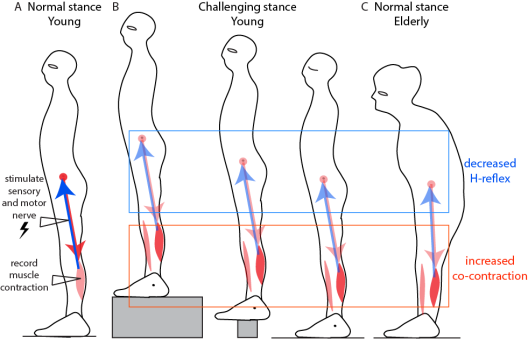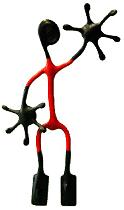Neuromechanical control of standing balance

Purpose: Development of balance training interventions to prevent falling
After an injury, the onset of a neuro-degenerative disease, or simply during healthy ageing, there is an increase in balance impairments. These are associated with a loss of independence, reduced quality of life, and an increased risk of falling, hospitalisation, and premature death. The purpose of the project is to prevent falling and fall-related injuries through the development of individualised balance training interventions.
Background: Balance relies on ankle stiffness and spinal feedback
During stance, external perturbation forces may compromise stability. The fastest change in muscle contraction after a perpetuation is provided by the spinal stretch reflex. After a forwards push for example, the calf muscle is stretched. This is sensed by the sensory fibres embedded within the calf muscle (Figure 1.A, blue arrow), which directly excite the motor neurons of the calf muscle within the spinal cord (Figure 1.A, red dot and arrow). This response takes about 100ms, and during this delay the body falls freely. Ankle stiffness slows down the body fall during this delay, which reduces the threat to balance.
Previous work: Modelling the co-adjustment of ankle stiffness and spinal feedback
The efficiency of the balance-correcting response depends on the spinal feedback gain, i.e. the scaling between ankle stretch and the resulting contraction. Dr. Le Mouel recently developed a novel method for determining the “critical” feedback gain, for which perturbations are cancelled the fastest without overshoot (Le Mouel & Brette, 2019). This modelling study predicts that an increase in either stiffness or neural delay must be coordinated with a decrease in spinal feedback gain, to prevent over-compensation.
Current work: Impact of balance training on neuromechanical control
We perform experimental work to determine the effect of different balance training interventions on the neuromechanical control of stance. Our hypothesis is that improved balance relies on improved co-adjustment of ankle stiffness and sensorimotor feedback. We analyse the changes in neuromechanical control and balance:
• after skateboard practice in children with ADHD, with Dr. Christiane Bohn, Dr. Charlotte Le Mouel and Kathrin Czichon
• during physiotherapy in patients with chronic ankle instability, with Dr. Rosemary Dubbeldam, Lena Fennen, Dr. Charlotte Le Mouel and Elias Grosse
Publications:
Le Mouel, C., and Brette, R. (2019). Anticipatory coadaptation of ankle stiffness and sensorimotor gain for standing balance. PLOS Computational Biology 15: e1007463. doi.org/10.1371/journal.pcbi.1007463


